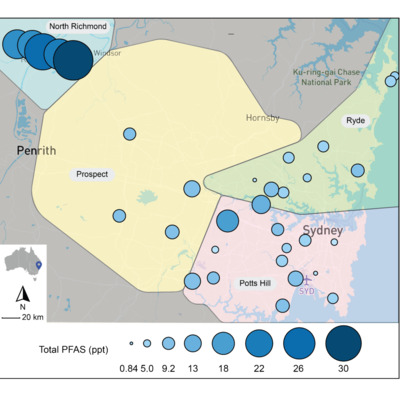Sydney's tap water contains more PFAS than previously thought

Researchers from UNSW Sydney have identified 21 new per- and polyfluoroalkyl substances (PFAS) in Sydney’s tap water, bringing the known total to 31 types. The researchers say their findings, published in the journal Chemosphere, reinforce the need for broader PFAS monitoring.
PFAS compounds — which have been widely used in firefighting foams, non-stick cookware, waterproof materials and industrial manufacturing — are often dubbed ‘forever chemicals’ because they don’t break down naturally and persist in the environment and human body for decades. While official health guidance says there is currently limited evidence of human disease or other clinically significant harm resulting from PFAS exposure, Australian guidelines are designed to minimise risk over a lifetime.
The UNSW researchers analysed 32 tap water and 10 bottled water samples taken from the Sydney water catchment areas in early 2024, including 10 sites in the Ryde catchment, 13 in Potts Hill, four in Prospect and five in North Richmond. Leading the laboratory analysis was Dr Lisa Hua, who used specialised resins that were able to extract PFAS compounds from water samples brought back to the lab. She then utilised a technique called mass spectrometry that identifies chemicals by measuring the weight of their molecules — and is so sensitive it can pick up PFAS at parts per trillion (ppt).
According to lead author Professor William Alexander Donald, the PFAS profiles detected depended on catchment, with higher concentrations near likely contamination sites. For example, the team found PFOS — a legacy firefighting foam chemical and known carcinogen — in some North Richmond samples with a reading of 6 ppt, which is 2 ppt below Australia’s guidelines of 8 ppt but higher than the US EPA’s advisory limit of 4 ppt.
“Sydney’s water meets current Australian standards, but when considering health benchmarks used in other countries, some samples were near or above safety limits,” Donald said.
Another finding was the first ever detection in Australian tap water of 3:3 FTCA, a short-chain breakdown product from firefighting foams which has only once before been reported in a drinking water supply worldwide. There is currently no established toxicity data or regulatory limit for this specific compound in drinking water, although its presence raises concern due to its chemical similarity to other PFAS known to pose health risks.
Another detected compound, 6:2 diPAP, had previously been found in bottled water and other consumer environments but not in tap water. According to the researchers, limited evidence from early studies suggests 6:2 diPAP may affect thyroid and reproductive systems, but further research is needed.
“This study reports the first detection of this PFAS in tap water globally,” Donald said.
“Detecting PFAS not previously reported in tap water highlights that our monitoring programs are now uncovering more of the chemicals present in our supply.”
The most abundant compound detected on average — present in every tap water sample — was PFBA, a short-chain PFAS. It’s a common breakdown product of other PFAS and is now attracting scientific attention because it’s increasingly used as a replacement for regulated long-chain PFAS, yet remains highly mobile in water and environmentally persistent. While PFBA builds up in the body less than longer-chain PFAS, the researchers noted that some early studies suggest potential effects on liver, thyroid and developmental health.
“This highlights that we are stuck in a whack-a-mole situation with PFAS,” Donald said.
“Tiny tweaks to the chemical structure create a ‘new’ compound, but the toxicology research and regulatory work has to start all over again every time a PFAS is tweaked.”
Where to now?
While Hua said it “should be reassuring” that the detected PFAS concentrations were low, she added that we “should explore new technologies that remove PFAS before their release into our ecosystems and drinking water supply”. The good news is, Hua, Donald and colleagues recently published a study in the Journal of Hazardous Materials identifying a material that, when added to water at trace levels, can remove more than 99% of PFAS at environmentally relevant concentrations. They are now also working on materials designed to absorb PFAS from water and break it down entirely.
Other proposed next steps include expanding PFAS monitoring across Australia, which could involve a nationwide survey to assess PFAS levels in both urban and remote areas. The researchers recommend that monitoring be broadened to include more PFAS compounds, which would help generate more comprehensive data tracking over time.
“Expanding the current monitoring of PFAS could be beneficial to gain a greater understanding of seasonal variations of PFAS in drinking water supply,” Hua said.
MRI scanner to advance medical breakthroughs at Monash
Siemens Healthineers' MAGNETOM Cima.X 3T is claimed to be Victoria's most advanced,...
Virtual pathology streamlines rapid onsite evaluation
Technology from Grundium, a specialist in digital imaging for pathology, has been shown to match...
Cannabis detected in breath from edibles
Researchers say they have made the first measurement of THC in breath from edible cannabis, in a...






